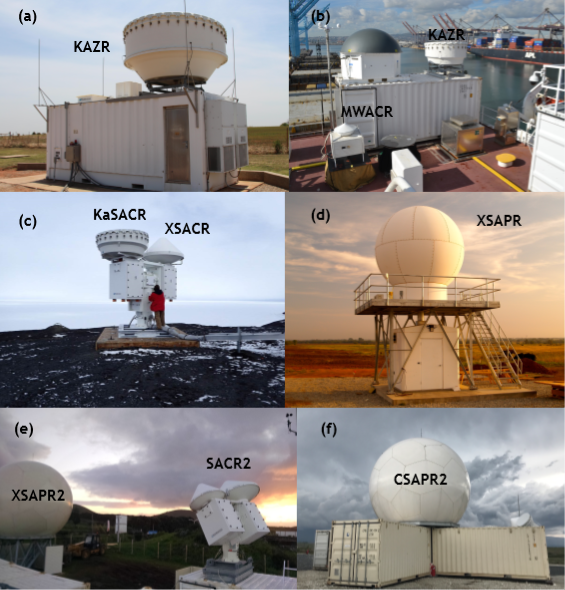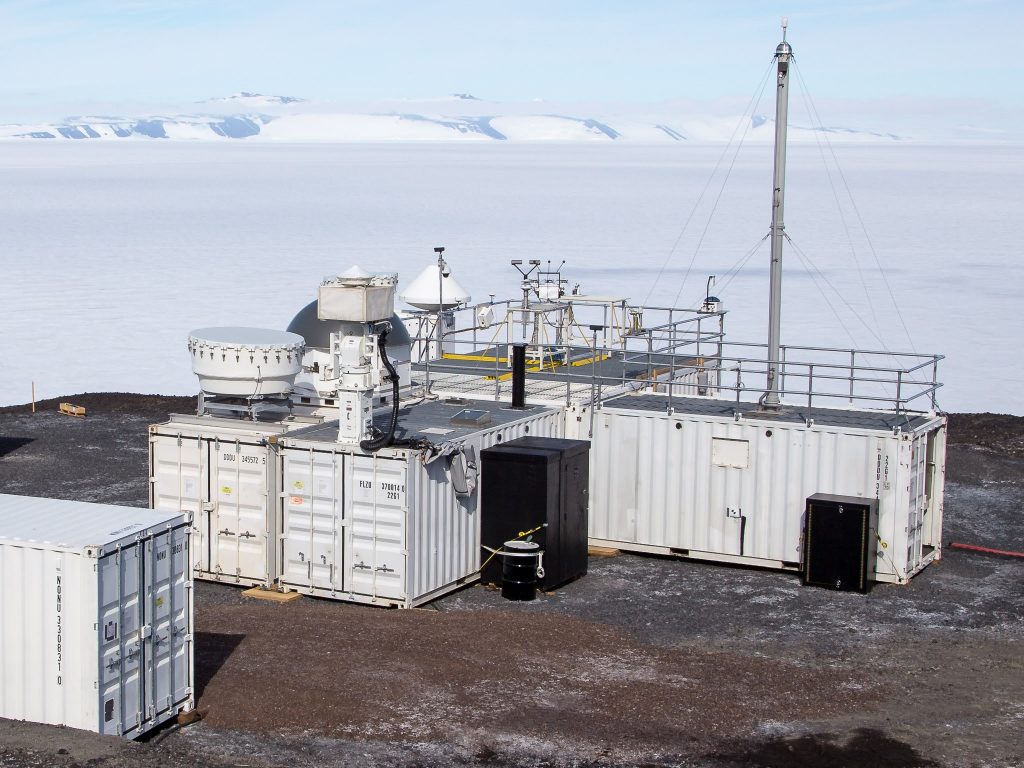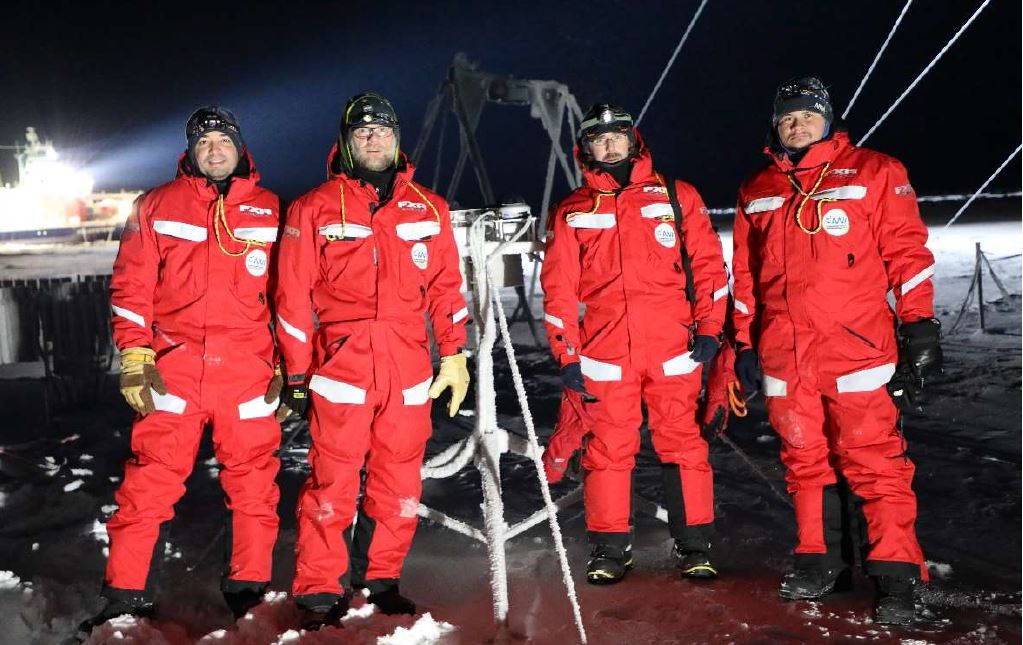Changes on the ARM Personnel Radar
Published: 19 January 2021
Iosif “Andrei” Lindenmaier now leads the ARM radar systems engineering group, and Timothy Wendler and Vagner Castro join the team

In the spring and summer of 2020, two changes appeared on the organizational radar of the U.S. Department of Energy’s Atmospheric Radiation Measurement (ARM) user facility. ARM’s radar systems engineering group, which oversees hardware and operations, had one promotion and one hire.
Iosif “Andrei” Lindenmaier, who has been with ARM as a radar engineer since 2012, stepped into the role of radar systems engineering lead. Timothy “Tim” Wendler, who was a postdoctoral researcher at Pennsylvania State University, joined ARM on July 6 as the radar group’s newest engineer and instrument mentor.
Both are at Pacific Northwest National Laboratory (PNNL) in southeastern Washington state.
In October, the group recorded another change when longtime ARM radar technician Vagner Castro started as an operations specialist. He will assist radar engineers by installing, upgrading, and troubleshooting radars during field campaigns, just as he has during five campaigns since 2013.
From his home base at PNNL, Castro―university-trained as an information technology analyst―will also help track, ship, and purchase ARM radar gear.
ARM’s radar organization also includes radar translators―data interpreters―at Brookhaven National Laboratory on Long Island, New York, and Argonne National Laboratory near Chicago, Illinois.
The ARM radar group directly in charge of operations and instruments is at PNNL, under the direction of Lindenmaier. The ARM radar group overseeing data, software, and applications―newly split into its own entity―is awaiting a new lead. (See the job announcement for the new radar data mentor.)
Radars―From One to Many

Radars are a key instrument for observing details of clouds and precipitation. These devices send out pulses of electromagnetic waves that scatter back from an object in the form of interpretable signals. The energy that is scattered back to the radar receiver by the cloud and precipitation particles depends on both the frequency of the transmitted radar beam and the properties of the particles.
Radar data can provide information about the location, amount, size, and composition (water or ice) of cloud and precipitation particles.
To help capture such signals from clouds and related phenomena, ARM installed its first radar in 1996, but its radar group was as small as just one person until about 2010. It grew rapidly after that, once the user facility greatly expanded its radar capabilities. Among other things, ARM added radars in four frequency bands across a wide range of scattering regimes and also added scanning radar capabilities.
Today there are 20-plus ARM radars in critical locations around the globe―the largest array of meteorological research radars in the world.
ARM’s original radar capabilities illustrated ARM’s traditional interest in measuring phenomena within a narrow vertical column by using zenith-pointing devices. However, the expansion to scanning radars starting in 2010 broadened ARM’s view.
“We are also interested in the region around the column―in three-dimensional space,” says ARM Technical Director Jim Mather.
Scanning radars “give us information about that space,” he says, “and also help us retrieve properties that cannot be determined with an instrument that is zenith-pointing,” such as ice-crystal processes.
Coordinating, Calibrating, Delivering Data
“I will do my best. Slowly, slowly, we are getting back to normal.”
Andrei Lindenmaier, ARM radar systems engineering lead, acknowledging pandemic-related interruptions
The ARM radar mentor group is responsible for managing radar operations. Others in ARM, including site operations specialists, translators, and data product developers, work with the PNNL-based group to produce the radar data needed by the science community.
“It’s a complicated puzzle,” says Mather.
Collectively, the radar mentor group has a big job. Team members calibrate and maintain radars from a variety of manufacturers, install them in often-challenging remote locations, deliver high-quality data, and flexibly cope with the pressing schedules of field campaigns.
Since early April 2020, a big part of coordinating all of that has fallen to Lindenmaier. He spends about two days a week on the PNNL campus and the rest working from home.
“I will do my best,” says Lindenmaier of his role, acknowledging interruptions because of the pandemic. “Slowly, slowly, we are getting back to normal.”
On July 22, he and Wendler worked at PNNL to calibrate dual Ka- and X-band Doppler radars, readying the devices for a future ARM field campaign. It was Wendler’s first trip to campus since his early July start date.
Have Radar, Will Travel

ARM radar engineers and technicians travel a lot for work and will likely do so again once pandemic restrictions are in the history books.
Wendler, who went to high school in Oregon, about an hour’s drive from PNNL, expects that about 30% of his time will be on the road, domestically and internationally.
“That part I am looking forward to,” he says.
Lindenmaier, who earned his PhD in physics in his native Romania, has over the years traveled to ARM sites in Oklahoma, Antarctica, Alaska, the Azores, and Finland. With a few exceptions, it has been cold-weather work.
In Antarctica, he prepared and installed radars for the 2015–2017 ARM West Antarctic Radiation Experiment (AWARE).
“This was a successful campaign,” says Lindenmaier, who points out that summertime Antarctica is “colder than Finland in winter.”
During AWARE, the second ARM Mobile Facility was in the field, one of three ARM Mobile Facilities deployed around the world for campaigns up to a year at a time, on average.
“Based on that accumulated experience” during AWARE, says Lindenmaier, “I prepared the same radars (in 2019) for the Multidisciplinary Drifting Observatory for the Study of Arctic Climate (MOSAiC) campaign.”
In Tromsø, Norway, the departure point for MOSAiC researchers, he designed a special platform for the scanning ARM cloud radar on the space-constrained deck of the R/V Polarstern. The German research icebreaker was the expedition’s chief instrument platform and ice-locked laboratory.
MOSAiC wrapped in October 2020.
‘I Feel Very Important Here’

Working with radars appeals to Wendler, who says, “I like the hardware.”
His degrees are in physics (B.S. from Utah Valley University, PhD from Brigham Young University), pursued after growing up in a variety of states, including Arizona, Idaho, and finally Oregon. (His father, an emergency room physician, took on a circuit of jobs to finish his residency, then to help pay off medical school loans.)
Early on, Wendler’s physics studies took a turn toward the practical. As an undergraduate, he worked on solar energy telemetry analysis and photovoltaic cells. In his doctoral work, Wendler modeled the quantum dynamics of reactive collisions and visualized the results in three dimensions.
His professional radar work started with U.S. Department of Defense applications at a Naval Air Systems Command facility in California. It included signal processing for multi-band radar systems.
At Penn State, Wendler was part of a multi-institutional neutrino mass experiment called Project 8, which brought him in contact with PNNL researchers. He also dealt with radio frequency hardware, though in the context of cyclotron (particle accelerator) radiation experiments.
The idea of radars applied to atmospheric science is very appealing, he says.
“It is the most important, relevant field I’ve ever been in,” says Wendler. “It’s the new level of responsibility I’ve been looking for. I feel very important here.”
Snow, Snakes, and Tiny Screws

If grades were being handed out for being part of ARM, Castro would get an A. After all, since 2013, he has done work for the user facility in a lot of alphabetically A-list places: Australia, the Amazon, Antarctica, Argentina, and—most recently—in the Arctic.
Along the way, the native of Brazil has been battered by snow at both poles of the Earth, beset by snakes in the Amazon rainforest, and challenged by frequent climbs to the monkey deck high up on a research icebreaker in the central Arctic. More than once, gloveless, he replaced a set of tiny screws on the inlet door of an aerosol sampler. Snow, snakes, or screws, Castro loved every minute of it.
In all of Castro’s travels for ARM, one item of gear has stayed the same: the pair of sunglasses he bought in Australia during his first ARM training at the now-closed Tropical Western Pacific atmospheric observatory in Darwin.
“I have replaced everything—boots, work clothes,” says Castro. “But my sunglasses are the same, except I changed the lenses.”
In 2011, the lenses of his whole life changed. Determined to study English, Castro moved from his hometown of Itaperuna in southeastern Brazil to Melbourne, Australia. Behind him was a career as a telecommunications data analyst. Ahead of him was two years of formal language study. He made ends meet by working at a restaurant and a car wash, and as a cleaner.
‘Everything’s Perfect’
In 2013, hard work paid off when a contractor advertised for an information technology expert who spoke English and Portuguese. Destination: ARM’s Green Ocean Amazon (GoAmazon2014/15) field campaign in Brazil.
“It was perfect for me,” says Castro, who had just married the year before. (His wife, Gizela, a registered nurse who can find work easily, has been with him on every ARM campaign except the one in the Arctic.)

He traveled to Darwin to visit the ARM site there.
“I saw it and I was in love,” he says, remembering the impressive radars and the racks of computers that steered them and the prospect of working with his hands. “I said to myself, ‘This is what I want to do for the rest of my life.’”
Castro joined ARM in June 2013 and has been on the road ever since, including 19 months on Ascension Island in the South Atlantic during ARM’s 2016–2017 Layered Atlantic Smoke Interactions with Clouds (LASIC) field campaign. Along the way during the ARM work, he and Gizela decamped to the big family home in Itaperuna. Their apartment in Richland is the first home of their own in seven years.
Looking back, Castro regrets not being able to say goodbye to the ARM mentors, technicians, and staff he worked with for so long―right up until leaving the group when MOSAiC wrapped up in October. (For four months early in the yearlong expedition, Castro set up and then watched over ARM instrumentation aboard the ship and on the ice.)
“I will always be grateful,” he says.
Soon, at least for a week or two at a time, Castro will be on the road again. He’ll help pack up a huge C-Band Scanning ARM Precipitation Radar at the Southern Great Plains atmospheric observatory, then set it up in Houston, Texas. The radar will contribute to ARM’s TRacking Aerosols Convection interactions ExpeRiment (TRACER), slated to last a year.
Getting to Richland in October cost Castro and his wife a pandemic-related delay of seven months in Brazil. Now they are a 10-minute walk from the PNNL campus, with a view of trees and farm fields.
“Everything’s perfect,” he says. “I want to live here forever now.”
Keep up with the Atmospheric Observer
Updates on ARM news, events, and opportunities delivered to your inbox
ARM User Profile
ARM welcomes users from all institutions and nations. A free ARM user account is needed to access ARM data.


















